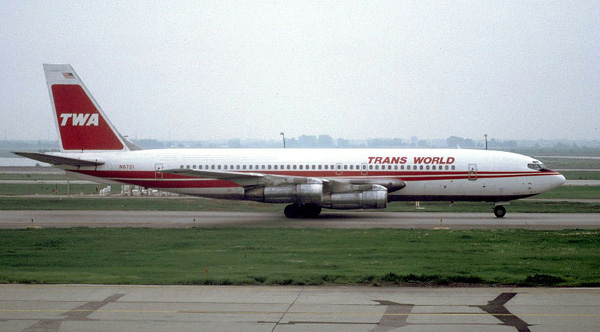Boeing 707
Labels: aircraft history , aircraft model , airline history , aviation , aviation history , first boeing , general knowledge , historical event , 0 comments
Aircraft details:

The Boeing 707 is a four-engine commercial passenger jet airliner developed by Boeing in the early 1950s. Its name is most commonly spoken as "Seven Oh Seven". Boeing delivered a total of 1,010 Boeing 707s, which dominated passenger air transport in the 1960s and remained common through the 1970s. Boeing also offered a smaller, faster version of the aircraft that was marketed as the Boeing 720.
Engine:
The 707's engines could not supply sufficient for bleed air for pressurizations without a serious loss of thrust, so the aircraft instead used engine-driven turbo compressor to supply high-pressure air for this purpose. On many commercial 707s the outer port (#1) engine mount is distinctly different from the other three, as this is the only engine not fitted with a turbo compressor. The Boeing 707 was the first commercially successful airliner to use podded engines
high-pressure air for this purpose. On many commercial 707s the outer port (#1) engine mount is distinctly different from the other three, as this is the only engine not fitted with a turbo compressor. The Boeing 707 was the first commercially successful airliner to use podded engines

Some models:
- 707-320B: A re-engining of the stretched version was undertaken in parallel with the -120B, using the same JT3D-3 turbofans and incorporating many of the same airframe upgrades as well. Takeoff gross weight was increased to 335,000 lb (152,000 kg). 175 of the 707-300B aircraft were produced, as well as upgrades from original -320 models. One of the final orders was by the Iranian Government for 14 707-3J9C aircraft capable of VIP transportation, communication, and inflight refuelling tasks.
- 707-320B Advanced: A minor improvement made available to -320B aircraft, adding three-section leading-edge flaps. These reduced takeoff and landing speeds, and also altered the lift distribution of the wing, allowing the ventral fin found on earlier 707s to be removed. The same wing was also used on the -320C.
- 707-320C: A convertible passenger/freight configuration which became the most widely produced variant of the 707, the -320C added a strengthened floor and a new cargo door to the -320B model. 335 of these variants were built, including a small number with uprated JT3D-7 engines and a takeoff gross weight of 336,000 lb (152,000 kg). Despite the convertible option, a number of these were delivered as pure freighters.
Specification:
| | 720 (707-020) | 707-120B | 707-320B |
|---|---|---|---|
| Passengers | 140 | 110 (2 class) 179 (1 class) | 147 (2 class) 202 (1 class) |
| Maximum takeoff weight(MTOW) | 222,000 lb (100,800 kg) | 257,000 lb (116,570 kg) | 333,600 lb (151,320 kg) |
| Empty weight | 103,145 lb (46,785 kg) | 122,533 lb (55,580 kg) | 146,400 lb (66,406 kg) |
| Takeoff run at MTOW | 8,300 ft (2,515 m) | 11,000 ft (3,330 m) | 10,840 ft (3,280 m) |
| Landing run | 5,750 ft (1,740 m) | 6,200 ft (1,875 m) | 10,840 ft (3,280 m) |
| Operating range (Max Payload) | 3,680 NM(6,800 km) | 3,680 NM (6,820 km) | 3,735 NM (6,920 km) |
| Cruising speed | 540 kn (999 km/h) | 540 kn (1000 km/h) | 525 kn (972 km/h) |
| Length | 136 ft 2 in (41.25 m) | 144 ft 6 in (44.07 m) | 152 ft 11 in (46.61 m) |
| Wingspan | 130 ft 10 in (39.90 m) | 145 ft 9 in (44.42 m) | |
| Tail height | 41 ft 7 in (12.65 m) | 42 ft 5 in (12.93 m) | 42 ft 5 in (12.93 m) |
| Fuselage width | 12 ft 4 in (3.76 m) | 12 ft 4 in (3.76 m) | |
| Powerplants (4 x) | Pratt & Whitney JT3C-7: 12,000 lbf (53.3 kN) | Pratt & Whitney JT3D-1: 17,000 lbf (75.6 kN) | PW JT3D-3: 18,000 lbf (80 kN) PW JT3D-7: 19,000 lbf (84.4 kN) |
 RSS Feed
RSS Feed Twitter
Twitter
0 Response to "Boeing 707"
Post a Comment
Submit what you know about games.It will be published in
this site